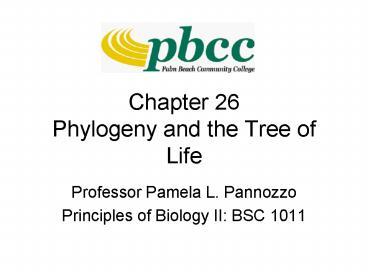Chapter 26 Phylogeny and the Tree of Life - PowerPoint PPT Presentation
1 / 16
Title:
Chapter 26 Phylogeny and the Tree of Life
Description:
Family: Felidae. Order: Carnivora. Class: Mammalia. Phylum: Chordata. Kingdom: Animalia ... Felidae. Mustelidae. Canidae. Canis. Lutra. Taxidea. Panthera ... – PowerPoint PPT presentation
Number of Views:102
Avg rating:3.0/5.0
Title: Chapter 26 Phylogeny and the Tree of Life
1
Chapter 26Phylogeny and the Tree of Life
- Professor Pamela L. Pannozzo
- Principles of Biology II BSC 1011
2
How Do We Trace and Organize Evolutionary
Relationships?
- Phylogeny the evolutionary history of a species
or group of species - Systematics study of classifying organisms
based on evolutionary relationships - Taxonomy study of naming and classifying
organisms
3
Classification
- Binomial nomenclature
- Homo sapiens
- Linnaean system of classification
4
Phylogenetic Trees
5
Branch point (node)
Taxon A
Taxon B
Sister taxa
Taxon C
ANCESTRAL LINEAGE
Taxon D
Taxon E
Taxon F
Common ancestor of taxa AF
Polytomy
6
Ways We Determine Phylogenies
- Morphological similarities
- Homologous vs. analogous structures
- Molecular homologies
7
Divergent Evolution
- The evolution of different species from a common
ancestor
8
Convergent Evolution
- The evolution of similar features in independent
evolutionary lineages
9
Similar DNA Sequences
- Align comparable sequences
- Analyze for insertions and deletions
- Percentage of DNA differences correlated with
evolutionary relatedness
10
Cladistics
- Monophyletic group an ancestral specia and all
of its descendants - Paraphyletic group an ancestral species and
some of its descendants - Polyphyletic group two or more ancestral
species and their descendants
11
Phylogenetic Trees are Constructed Based on
Shared Characteristics
12
Evolutionary History of Documented in Genomes
- Different genes evolve at different rates
- Allows comparisons of genomes of different
organisms - 50 human and yeast genes orthologous
- 99 human and mice genes orthologous
- Number of genes not correlated with phenotypic
complexity
13
Molecular Clocks
- Graph of the number of mutations that have
occurred in a gene over time - Assumption that some genes evolve at constant
rates - Number of base substitutions between two genes is
proportional to time elapsed since divergence
from common ancestor - Can use nucleotides, codons, or amino acids
14
Molecular Clocks
15
Current Domains Classification
16
Tree of Life Based on rRNA
? major horizontal gene transfer































